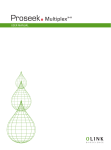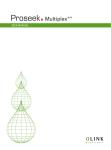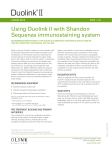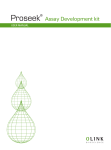Download 0935 v1.1 Proseek Multiplex User Manual - final
Transcript
Multiplex 96×96 User Manual Technical support For technical support, please contact us at [email protected] or +46 18 444 3970 Table of content 1. Introduction 4 2. Principle of the assay 2.1 Technology and assay format 5 5 3. Reagents and equipment 3.1 Reagents supplied 3.2 Required consumables (not supplied) 3.3 Required equipment (not supplied) 3.4 Downloads 3.5 Software for analysis 6 6 7 7 7 7 4. Assay considerations 4.1 Safety 4.2 PCR Technology 4.3 Pipetting techniques 4.4 Sample preparation 4.5 Sample material 8 8 8 8 8 8 5. Assay protocol 5.1 Plate layout 5.2 PEA Program 5.3 Olink Protein Expression 96×96 program 5.4 Fluidigm instructions 5.5 Proseek Multiplex96×96 protocol 9 9 10 10 10 11 6. Results and data analysis 15 7. References 15 Appendix 1 16 Proseek Multiplex96×96 3 1. Introduction Proseek® Multiplex96×96 from Olink Bioscience is a diverse product line of reagents for scalable immunoassays enabling simultaneous measurement of 92 protein biomarkers in 1 µL sample volume. The Proseek platform is designed for ease of use and offers enhanced analytical performance, analysis of complex matrices, as well as improvement in assay throughput over conventional immunoassays. To get you started, Proseek Multiplex96×96 reagents come as a convenient all-in-one kit format with an optimized protocol. 4 Proseek Multiplex96×96 2. Principle of the assay 2.1 Technology and assay format The Proseek reagents are based on PEA, a Proximity Extension Assay technology1, in which 96 oligonucleotide-labeled antibody pairs are allowed to bind to their respective protein targets in the sample. A PCR reporter sequence is formed by a proximity-dependent DNA polymerization event and is subsequently detected and quantified using real time PCR. The assay is performed in a homogeneous 96-well format with no need for washing steps. Proseek Multiplex assay procedure employs three core steps: Incubation Extension Allow the 96 antibody probe pairs to bind to their respective proteins in your samples. Create and pre-amplify 96 unique DNA reporter sequences by proximity extension. Detection Quantify each biomarker’s DNA reporter using high throughput real-time qPCR instrument. Fig 1. Assay procedure. Proseek Multiplex96×96 5 3. Reagents and equipment 3.1 Reagents supplied Each Proseek Multiplex 96×96 kit contains reagents for 96 wells, sufficient for 92 samples and 4 controls. The reagents are supplied in three individual boxes. Storage temperature and expiry date for the components are stated on the outer label of each box. 3.1.1 Proseek Multiplex Probe Kit 96×96 (store at +4°C) Incubation Solution Contains components needed for the incubation reaction A-probes Contains 96 antibody probes labeled with A oligos B-probes Contains 96 antibody probes labeled with B oligos 3.1.2 Proseek Multiplex Detection Kit 96×96 (store at -20°C) PEA Solution Contains components needed for the extension reaction PEA Enzyme For extension of A and B probes which are bound to their target PCR Polymerase For pre-amplification of the extension product created by the PEA enzyme Detection Solution Contains components needed for the detection reaction Detection Enzyme For qPCR amplification Primer Plate 96-well plate with ready-to-use primers for amplification of extension product Incubation Stabilizer For stabilization of the incubation reaction 3.1.3 Proseek Multiplex Controls (store at -20°C) 6 Positive Control Contains three control assays Negative Control For normalization and determination of background levels Proseek Multiplex96×96 3.2 Required consumables (not supplied) Pipette tips (filter is recommended) Microcentrifuge tubes (1-1.5 mL) Centrifuge tube (> 11 mL) 8-well strips with lids 96-well PCR plate (à 0.2 mL) Multi-channel pipette reservoir Adhesive plastic film (heat-resistant) High purity water (sterile filtered, MilliQ® or similar) 96.96 Dynamic Array™ Integrated Fluidic Circuit (IFC), (Fluidigm Corporation, catalogue number BMK-M96.96) 3.3 Required equipment (not supplied) Pipettes (covering the range from 1 μL to 1000 μL) Multi-channel pipettes (for volumes 1-10 µL, 96 µL) Vortex Centrifuge for plates Microcentrifuge for tubes Freezing block (-20°C) for enzyme handling Thermal cycler with heated lid (recommended format;96-well, minimum 0.1 mL) Refrigerator or cold room (+2°C to +8°C) Fluidigm BioMark™ System Fluidigm IFC controller HX 3.4 Downloads To be able to properly analyse your results, a DetectorTemplate.plt file is recommended to be used with the Fluidigm Analysis software and availble for download at www.olink.com. If applying the sample plate layout suggested on page 9, a Default Sample Names file is availble for download. 3.5 Software for analysis Each Proseek Multiplex 96×96 experiment will generate 9216 data points on the Fluidigm BioMark real-time PCR instrument. GenEx by MultiD AB offers an easy-to-use plugin Olink Wizard, for analysis of Proseek Multiplex 96×96 results. The Olink Wizard will guide you through the different steps of acquiring protein expression data. Proseek Multiplex96×96 7 4. Assay considerations 4.1 Safety Follow general laboratory safety procedure such as using gloves, safety goggles and protective clothing when performing the experiments. Handle and dispose of hazardous sample material according to local regulations. 4.2 PCR Technology PCR technology is sensitive to contaminations; perform the Detection step in a post-PCR room, separate from the room where the Incubation and Extension steps are performed. Never transfer amplified products to bench or fume hoods. 4.3 Pipetting techniques It is advisable to use a multi-channel pipette in the reagent transfer steps. Use filter pipette tips to avoid contamination. Change pipette tips between all sample and reagent transfer steps to avoid cross-contamination. Maintain and calibrate your pipettes regularly. 4.4 Sample preparation To reduce sample-handling time during the experiment, samples can be aliquoted in 8-well strips or 96-well plate prior to the start of the experiment. 4.5 Sample material Proseek Multiplex96×96 has been shown to be successful with the following sample types: Serum EDTA plasma Citrate plasma Heparin plasma Tissue and cell lysates Note: Optimization of lysis buffer may be necessary, depending on cell or tissue type. A recipe for the recommended lysis buffer is available upon request. For more information, please contact [email protected]. 8 Proseek Multiplex96×96 5. Assay protocol 5.1 Plate layout Prior to running the Proseek Multiplex96×96 assay, plan the distribution of samples across the plate. It is important to place the Negative Control and Positive Control in the first four wells, according to Figure 2 for a correct analysis using the Olink Wizard by GenEx. Each Proseek Multiplex96×96 kit is designed for 92 samples, three replicates of Negative Control and one Positive Control. For analysis of less than 92 samples, please pipette replicates of selected samples. 1 2 3 4 5 6 7 8 9 10 11 12 A B C D E F G H Negative control Positive control Samples Fig 2. Plate layout. Proseek Multiplex96×96 9 5.2 PEA Program Create a PEA program on the thermal cycler with the following conditions. Enable the heated lid function. Extension 50°C 20 min Hot start 95°C 5 min PCR Cycle Maintain the reaction at 95°C 30 s 54°C 1 min 60°C 1 min 10°C ∞, hold ×17 5.3 Olink Protein Expression 96×96 program Program the Fluidigm BioMark System with the following steps. Name the program Olink Protein Expression 96×96 program. 50°C 120 s 70°C 1800 s 25°C 600 s Hot Start 95°C 300 s PCR Cycle 95°C 15 s 60°C 60 s Thermal mix ×40 Verify correct settings: Application – Gene Expression Passive Reference – ROX Assay – single probe Probes – FAM-MGB 5.4 Fluidigm instructions For information on the Fluidigm IFC Controller HX and Fluidigm BioMark System, please read through the following User Guides (www.fluidigm.com) 10 Fluidigm® IFC Controller User Guide - PN 68000112 Fluidigm® Real-Time PCR Analysis User Guide - PN 68000088 Fluidigm® Data Collection Software User Guide - PN 68000127 Proseek Multiplex96×96 5.5 Proseek Multiplex96×96 protocol Before starting: Please read the entire Proseek Multiplex96×96 protocol. Decide how many samples you will include in the experiment and the number of replicates. Use the 96-well plate template in Figure 2 and select a location for each sample. Day 1: INCUBATION 1. Thaw samples, vortex and spin down the content at 1000 rpm, 1 min at room temperature. 2. Thaw the Incubation Stabilizer from the Proseek Multiplex Detection Kit 96×96 box, vortex and spin briefly. 3. Thaw the Positive Control and Negative Control from the Proseek Multiplex Controls box, vortex and spin briefly. 4. Prepare the following Incubation mix in a microcentrifuge tube. Vortex and spin each reagent before transfer to the mix. Incubation mix per 96-well plate (µL) Incubation Solution 263.0 Incubation Stabilizer 37.5 A-probes 37.5 B-probes Total Note: Pipette the Incubation Solution carefully to avoid foaming. 37.5 375.5 5. Vortex the Incubation mix briefly and spin down the content. Transfer 44 µL per well of the Incubation mix to an 8-well strip. 6. Use a multi-channel pipette to transfer 3 µL of the Incubation mix from the 8-well strip to each well of a 96-well plate by using reverse pipetting. Do not change pipette tips. Name this plate Incubation Plate. Note: Pipette from the uppermost part of the Incubation mix to prevent liquid from sticking to the outside of the pipette tip. 7. Add 1 µL of Negative Control to each well in position A1, B1 and C1 according to the plate layout in Figure 2. 8. Add 1 µL of Positive Control to well D1. Note: For steps 7–9; add the 1 µL liquid by placing the pipette tip into the 3 µL Incubation mix. 9. Add 1 µL of each sample to the Incubation Plate according to your plate layout. 10. Seal the Incubation Plate with an adhesive plastic film. It is important that all wells are properly sealed, especially around the edges to avoid evaporation of samples. Spin down the content 1000 rpm, 1 min at room temperature. 11. Incubate the Incubation Plate overnight at +4°C. Proseek Multiplex96×96 11 Day 2: EXTENSION 12. Turn on your thermal cycler and activate the heated lid function. 13. Thaw the PEA Solution, vortex and spin briefly. Prepare the following Extension mix in a centrifuge tube. Use a freezing block when removing the PEA Enzyme and the PCR Polymerase from -20°C and spin down the content briefly before pipetting the enzymes into the mix. Extension mix per 96-well plate (µL) High Purity Water 9385 PEA Solution 1100 PEA Enzyme 55 PCR Polymerase Total 22 10 562 14. Vortex the Extension mix. 15. Bring the Incubation Plate to room temperature. Spin down the content at 1000 rpm, 1 min at room temperature. 16. Pour the Extension mix into a multi-channel pipette reservoir. 17. Carefully remove the plastic adhesive film from the Incubation Plate. 18. Start a timer set for 5 min and transfer 96 µL of Extension mix to each well of the Incubation Plate using a multi-channel pipette. 19. Add a new plastic adhesive film to the Incubation Plate. It is important that all wells are properly sealed, especially around the edges to avoid evaporation of samples. Note: Perform steps 18–20 within 5 minutes. 5 min 20. Vortex gently and spin down the content at 1000 rpm, 1 min at room temperature. 21. After the 5 min, place the Incubation Plate in the thermal cycler and run the PEA program (see section 5.2 for details). The PEA program takes approximately 1 h 40 min. 22. Continue with the Detection step or store the Incubation Plate for up to one week at +4°C 12 Proseek Multiplex96×96 Note: If your thermal cycler requires a silicon cover for plates covered with plastic film, please use one to avoid evaporation. DETECTION 23. Prepare and prime a 96.96 Dynamic Array IFC according to the manufacturer’s instructions. 24. Thaw the Primer Plate and spin at 1000 rpm, 1 min at room temperature. 25. Thaw the Detection Solution, vortex and spin briefly. Prepare the following Detection mix in a microcentrifuge tube. Use a freezing block for the Detection Enzyme and PCR Polymerase and spin down the content briefly before pipetting the enzymes into the mix Detection mix per 96-well plate (µL) Detection Solution 550.0 High Purity Water 230.0 Detection Enzyme 7.8 PCR Polymerase 3.1 Total 790.9 26. Vortex the Detection mix and spin briefly. Transfer 95 µL of the Detection mix per well to an 8-well strip. 27. Use a multi-channel pipette to transfer 7.2 µL of Detection mix to each well of a new 96-well plate by reverse pipetting. Name this plate Sample Plate. 28. Remove the Incubation Plate from the thermal cycler and spin down the contents. 29. Carefully remove the plastic film and transfer 2.8 µL from each well of the Incubation Plate to the Sample Plate. 30. Seal the Sample Plate with a new plastic adhesive film, vortex and spin at 1000 rpm, 1 min at room temperature. Proseek Multiplex96×96 13 31. Transfer 5 µL from each well of the Sample Plate to the primed 96.96 Dynamic Array IFC by using reverse pipetting. Change pipette tips after each sample. Samples are loaded into their respective inlets on the right side of the chip according to Figure 3. See appendix 1 for a detailed instruction on sample loading. 32. Gently remove the Primer Plate aluminum sealing to avoid contamination between wells. Transfer 5 µL from each well of the Primer Plate into the inlets on the left side of the chip according to Figure 3 by reverse pipetting. Change pipette tips after each transfer. 1 2 3 4 5 6 7 8 9 10 11 12 1 A A B B C C D D E E F F G G H H 2 3 4 5 6 7 8 Primer Plate 9 10 11 12 Sample Plate Primers Samples Fig 3. Loading of samples and primers to the 96.96 Dynamic Array IFC. 33. Remove any visible bubbles. 34. Load the chip in the Fluidigm IFC Controller HX according to manufacturer’s instructions. 35. Run the Olink Protein Expression 96×96 Program in the Fluidigm Biomark Reader according to manufacturer’s instructions (See 5.3 for detailed instructions on the Olink Protein Expression 96×96 Program). 14 Proseek Multiplex96×96 Note: For steps 31 and 32, make sure not to leave any inlets empty on the chip. 6. Results and data analysis To facilitate data analysis Olink Bioscience has, together with MultiD, developed a module for GenEx to be used for data generated with the Proseek Mutliplex 96×96 assay reagent kit and Fluidigm BioMark System real-time instrument. With the Olink Wizard you will be able to pre-process your raw data for subsequent statistical analysis. The result file obtained from the Fluidigm BioMark real-time PCR Analysis software is exported to the GenEx software using the Olink data import wizard. Quality controls and normalization are performed automatically, providing you with normalized delta Cq values for further data analysis. After pre-processing is complete you can continue with statistical analysis. Different visualization tools are available, including scatter plot, box and whisker plot or bar graph, which allow you to rapidly identify major differences across samples. Additional features include hierarchical clustering methods, principal component analysis and more. For further information, please contact Olink at [email protected]. 7. References 1. Lundberg, M., et.al. Homogeneous antibody-based proximity extension assays provide sensitive and specific detection of lowabundant proteins in human blood. Nucleic Acid Res 6 June (2011). doi: 10.1093/nar/gkr424 Proseek Multiplex96×96 15 Appendix 1 Load samples to the right and primers to the left on the 96.96 Dynamic Array IFC. 1 2 3 4 5 6 7 8 9 10 11 12 1 A A B B C C D D E E F F G G H H 2 3 4 Primer Plate Proseek Multiplex96×96 6 7 8 9 10 11 12 Sample Plate Primers 16 5 Samples 1. Use reverse pipetting. Transfer 5 µL from each well in position 1 A-H (marked in green) to inlets in the first column on the right side of the chip (green). When using an eight-channel pipette every other inlet will be filled according to the image. 1 2 3 4 5 6 7 8 9 10 11 12 A B C D E F G H Sample Plate Samples Primers 2. Transfer 5 µL from each well in position 2 A-H (blue) to the second column of inlets (blue) according to image. Continue with columns 3-6. 1 2 3 4 5 6 7 8 9 10 11 12 A B C D E F G H Sample Plate Samples Primers 3. Transfer 5 µL from each well in position 7 A-H (red) to inlets in the first column on the right side of the chip (red), start on the second row according to image. Continue with columns 8-12. 1 2 3 4 5 6 7 8 9 10 11 12 A B C D E F G H Sample Plate Samples Primers 4. Transfer 5 µL from each well in the Primer Plate to the inlets on the left side of the chip in the same manner as described in steps 1-3 for Sample Plate. 1 2 3 4 5 6 7 8 9 10 11 12 A B C D E F G H Primer Plate Primers Samples Proseek Multiplex96×96 17 18 Proseek Multiplex96×96 Olink Bioscience Dag Hammarskjölds v. 52B SE-752 37 Uppsala, Sweden www.olink.com 0935, v.1.1, 2013-06-04 This product is for research use only. Not for use in human diagnostic or therapeutic procedures. This product includes a license for non-commercial use of Proseek products. Commercial users may require additional licenses. Please contact Olink AB for details. There are no warranties, expressed or implied, which extend beyond this description. Olink AB is not liable for property damage, personal injury, or economic loss caused by this product. The following trademarks are owned by Olink AB: Olink®, Olink Bioscience™, Proseek®, Duolink® and PLA®. This product is covered by several patents and patent applications including US 6,511,809, US 7,306,904, and related US and foreign patents. This product is sold under license from PHRI Properties, Inc. and may be used under PHRI Properties patent rights outside the field of human in vitro diagnostics. Components in the Proseek Multiplex Probe Kit utilise Lightning-Link™ technology and are provided under license from Innova Biosciences. © 2013 Olink AB. All third party trademarks are the property of their respective owners.






























